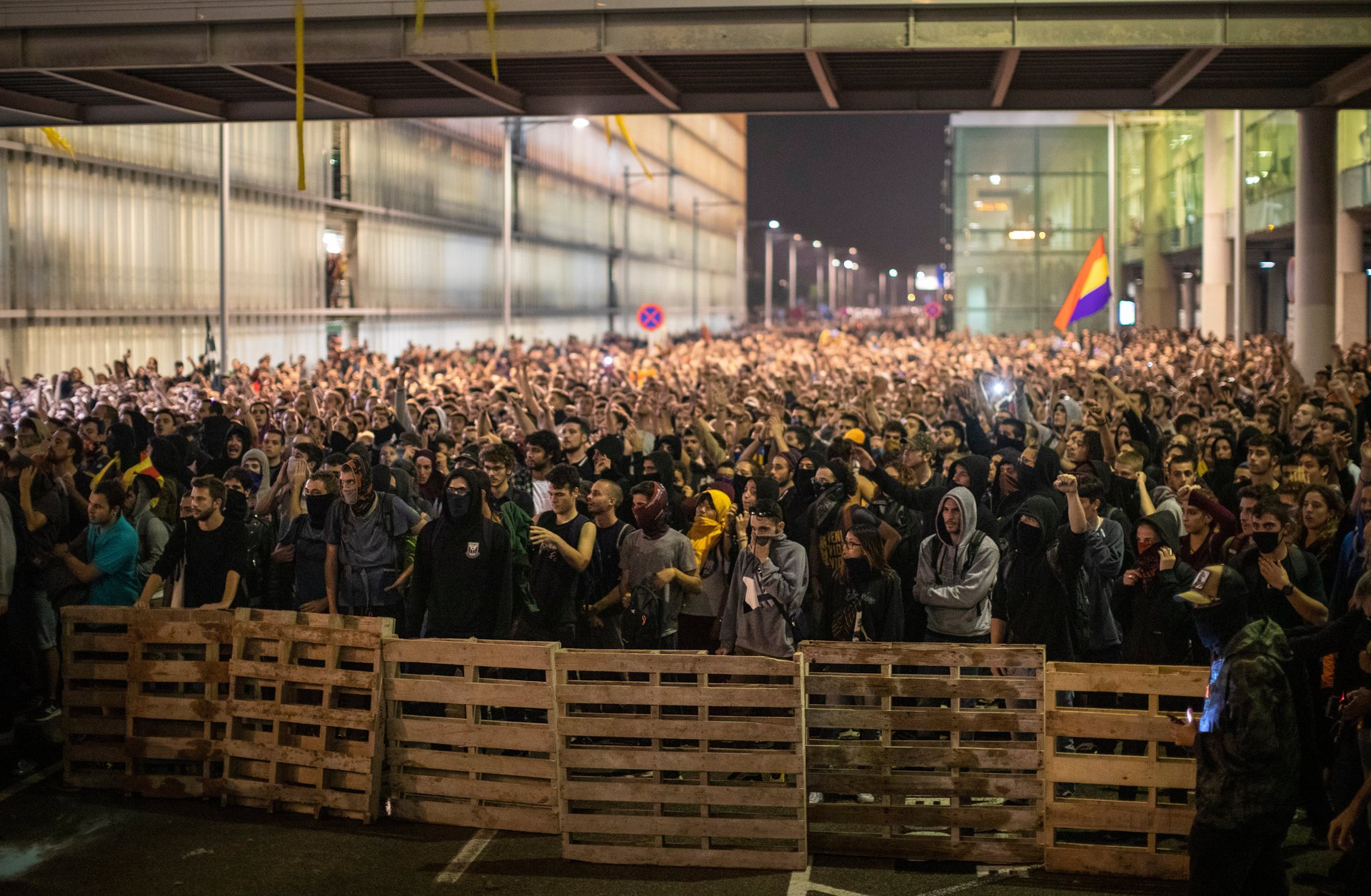Hong Kong is exporting its protest techniques around the world
The “Be Water” nature of Hong Kong’s protests—fluid, flexible, and fast-moving—has taken on a new form half way across the world in Catalonia: as a tsunami.


The “Be Water” nature of Hong Kong’s protests—fluid, flexible, and fast-moving—has taken on a new form half way across the world in Catalonia: as a tsunami.
After a Spanish court on Monday (Oct. 14) handed down lengthy jail terms to nine Catalan leaders for their roles in a 2017 secession attempt, tens of thousands of Catalans took to the streets to protest against what they saw as heavy-handed political persecution and blatant repression of the region’s political rights.
The protesters were answering the call to action from a group called Tsunami Democràtic, which launched in September (link in Spanish) urging mass peaceful and civil disobedience actions in order to safeguard Catalonia’s freedoms. Following the sentencing, protesters quickly gathered at plazas and on streets across the region, cutting off major thoroughfares and blocking traffic before heading en masse to their next target: Barcelona’s El Prat airport. As they set off from the city center, a group of youth shouted, “We’re going to do a Hong Kong!“
They were referring to what had happened at the Hong Kong airport almost exactly two months prior, when thousands of protesters forced the international transport hub to shut down. At Barcelona airport on Monday, strikingly similar scenes played out as thousands occupied both the terminal and the roads outside the building, eventually forcing the cancellation of at least 100 flights. Tsunami Democrátic even distributed some 130 boarding passes (link in Spanish) via the messaging app Telegram so that protesters could enter the airport, in a move reminiscent of some Hong Kong protesters who purchased cheap flights in order to enter the airport and circumvent a court ban on demonstrations at the building.
The months-long protests in Hong Kong have also been studied in Indonesia by students who took to the streets to oppose new laws, and Extinction Rebellion climate activists in the UK, but it is the Catalonia protests that appear to be most directly inspired by the Hong Kong playbook. For weeks, Catalan activists have examined the techniques of Hong Kong’s protesters closely, taking notes on what works and what might be successfully replicated in Catalonia. In late September, the grassroots group Assemblea Nacional Catalana even held a public forum titled, “Experiences of the use of new technologies in the nonviolent struggle: the case of Hong Kong.”
“We have been inspired a lot by the Hong Kong protests, although we are aware of the differences between both societies,” a representative of Picnic x República (link in Catalan), a digital platform designed to mobilize Catalans for political action, told Quartz. “The Hong Kong people have done a very good job in letting everybody else know about their fight through social networks… These are the first lessons we have learned from them: the use of these tools to mobilize the people and keep them informed.”
A page on Picnic x República’s website lists several Hong Kong protest-related Telegram channels (link in Catalan) as sources of inspiration and information, as well photos of Hong Kong protesters’ street-level organisation (link in Catalan). “The images and videos showing Hong Kongers’ discipline passing messages and goods all along the lines of action made a strong impression on us, although we are not sure we could achieve such perfection,” said the Picnic x República representative. “Maybe, with some time and practice!”
Perhaps the strongest tactical link between the two protest movements is the focus on the Bruce Lee-inspired “Be Water” philosophy, which translates into unpredictable, creative, and agile protests that flow like water and move quickly throughout the city.
Now, Catalan activists are similarly putting that thinking to use. On social media, Tsunami Democràtic has made use of the “Be Water” hashtag, and their call for everyone to be “a tsunami” quite literally embodies Bruce Lee’s philosophy in the flesh. Picnic x República has also embraced the importance of adapting quickly like water to changing situations, taking a page from Hong Kongers’ playbook by urging protesters to move fluidly in response to police actions and not to fixate on holding static positions.
That the Hong Kong movement has been able to sustain protests for over four months and continue to command international attention also serves as a model for Catalonia. Writing in a column last month, the Barcelona-born journalist and political commentator Jordi Barbeta held up Hong Kong as an example (link in Catalan) of a movement that has successfully given a “global dimension to a local conflict.” Picnic x República is aware of the importance of being in the global spotlight, too, and has encouraged Catalans to use masks “like those used in Hong Kong”—not only to protect protesters’ identity from the authorities, but also “reinforce the international image” of Catalonia’s fight. In this sense, Catalan activists are emulating the distinctive and highly recognisable optics of Hong Kong protesters—hard hats, respirator masks, and umbrellas and other eclectic shields—as both a preventative and performative act.
Beyond parallels in protest techniques, the Catalonia and Hong Kong movements share similarities in the nature of their struggles, said Joan Ramon Resina, a professor at Stanford University specializing in Spanish and Catalan literatures and cultures. Resina was also a signatory of a 2015 open letter alongside a group of Catalan scientists and academics in support of the pro-independence group Junts pel Sí (Together for Yes).
“Dictatorships like the Chinese and the resurging Spanish one do not tolerate dissidence or even cultural difference,” he said. “Thus, what the Hong Kong and the Catalan challenges to authoritarian regimes have in common is their value as symptoms for the growing impatience of peoples around the world with political systems that sacrifice the rights of minorities for the sake of expanding their power.”